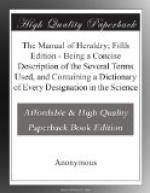Ex. Argent, a barrulet gules, belled with three bells proper.
BEND. One of the honourable ordinaries formed by two diagonal lines drawn from the dexter chief to the sinister base; it generally occupies a fifth part of the shield if uncharged, but if charged one third.
[Illustration: Bend]
Ex. Azure, a bend argent.
BEND SINISTER. Is the reverse of the bend; it is seldom found in coats of arms, as it is reckoned an abatement.
[Illustration: Bend sinister]
Ex. Argent, a bend sinister gules.
IN BEND. Figures placed in a slanting direction from the dexter chief to the sinister base are said to be in bend.
[Illustration: In bend]
Ex. Or, three torteaux in bend.
BENDLET. A diminutive of the bend, of the same shape, but only half the width of the bend.
BENDY. This word serves to denote a field divided diagonally into several bends, varying in metal and colour.
[Illustration: Bendy]
Ex. Bendy of six pieces, azure and argent.
BESANT, or BEZANT. Gold coin of Byzantium; when they appear in a coat of arms their colour is not described: a besant is always or.
[Illustration: Besant]
BILLETS. This charge is, by some authors, supposed to represent tiles or bricks; by others that it represents a letter or billet. The name and form of the charge most accords with the latter opinion.
[Illustration: Billets]
Ex. Argent, three billets azure, two over one.
BISHOPS. Church dignitaries: they are barons of the realm, and have precedence next to viscounts: they have the title of lords, and right reverend fathers in God.
BLAZON. To describe in proper colours, or lines representing colours, all that belongs to coats of arms. Arms may also be emblazoned by describing the charges and tinctures of a coat of arms in heraldic terms.
BLUE-MANTEL. A title of one of the pursuivants at arms. See HERALD.
BORDURE or BORDER. This was the most ancient difference in coats of arms, to distinguish different branches of the same family. It is a border round the edge of the shield. Its situation is always the same; but the inner edge may be varied.
[Illustration: Bordure]
Ex. Argent, a sinister hand couped at the wrist and erected gules, within a bordure azure.
BOTTONNY. See CROSS BOTTONNY.
BOUJET. An ancient water bucket, frequently borne in shields of arms.
[Illustration: Boujet]
Ex. Argent, a boujet proper.
BRACED. Two figures of the same form, interlacing each other.
[Illustration: Braced]
Ex. Vert, two triangles braced, argent.
BRASED and BRAZED are words sometimes used by ancient armorists. They always describe things interlaced or braced together.




